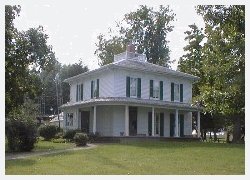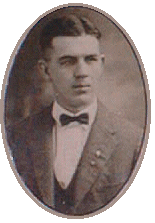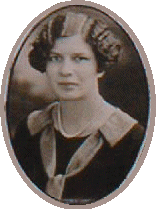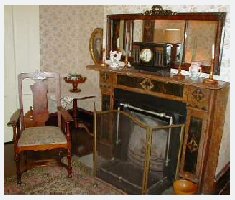In 1996, some of our chapter members thought it would be a fine idea to become
docents of the Ensor Farmsite and Museum. It was planned to be a fund-raising
effort for the chapter. Little did we realize how dedicated we would become to
the operations of this historic location!

The Ensor Farmsite and Museum was the home of Marshall H. Ensor, a pioneer in Amateur
Radio, and his sister, Loretta Ensor. The architecture of the farmhouse is typical of
the 1890s. The 1890 barn is made of rough-sawn lumber and wood-pegged beams. Inside the
house are found many antiques, furniture, clothing, memorabilia of the family, and
an assortment of crystal sets and radio transmtters built by Marshall Ensor.
Marshall H. Ensor (1899-1970), the only son of Jacob and Ida Ensor, lived
his entire life on this farm. However, he earned his living as a public school
teacher in Olathe. Marshall began teaching industrial arts in 1915 and except for
a period during World War II, he taught at Olathe High School until his retirement
in 1965.

In 2002, Marshall Ensor was posthumously named to the Hall of Fame at Olathe North
High School, honoring his half-century of service to Olathe schools.
William H. Paley, the president of CBS radio, honored one Amateur
radio operator each year until World War II curtailed all amateur radio broadcasting.
Ensor was the third and last winner of the William H. Paley Award in 1941,
for his 10 years of teaching code lessons over his home radio station, and for
helping more than 10,000 listeners become proficient operators. Marshall (W9BSP)
and Loretta Ensor(W9UA) were both very active in amateur radio and operated a
ham radio station for 50 years.

Loretta Ensor (1904-1991) was the only daughter of Ida and Jacob Ensor and lived
in this house for eighty-three of her eighty-seven years. Loretta worked several
years at the County Registrar's Office until illness forced her to resign. When
polio struck Jacob Ensor, Loretta took over tending the farm. After Loretta Ensor's
death in 1991, the farm became the Ensor Farmsite and Museum.

One of the most interesting features in the house is the radio room, found just off
the kitchen. Marshall Ensor's self-made kilowatt rig, in its handmade wooden cabinet,
immediately draws attention. Ensor's innovative ideas are found throughout the house.
The visitor imagines they are visiting a home where any moment the occupants may
return from farm chores or a trip to town, as furniture and belongings look much as
they did when the Ensors lived there. The radio transmitter is still in the
farmhouse kitchen as it has been since 1937.

The Ensor Farmsite and Museum is open to the public, June through September, Friday -
Sunday, 1:00-5:00 p.m. It is located at 18995 W. 183rd Street, about four miles south
of Olathe, and one mile east of 169 Highway. Tours of the farm are conducted by
members of the Daughters of the American Revolution.
In 2002, the Ensor Farmsite became the home of Santa Fe Trails Amateur Radio Club,
KSØKS. Ham radio signals are emanating
once again from the undisturbed and quiet aura of the Ensor Farmsite and Museum.
Then in April 2002, Marshall Ensor's radio call sign was reactivated both as a memorial
to his work and to draw attention to the fine museum. An organization called M.E.M.O. was
formed (Marshall Ensor Memorial Organization), which seeks to research and restore more
of Marshall's equipment, and to activate W9BSP radio.

